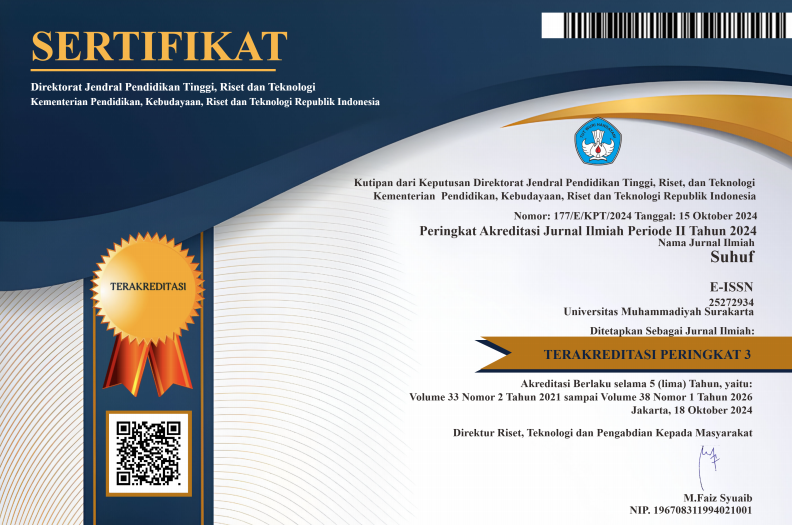Metaphorical Symbols in Qur'anic Discourse: A Cognitive-Linguistic Analysis
DOI:
https://doi.org/10.23917/suhuf.v37i2.12081Keywords:
Cognitive linguistics, Theological metaphors, Religious experience, Concrete meaningsAbstract
This article examines the relationship between language, thought, and religious experience in Islamic theology using George Lakoff’s cognitive linguistic framework. Focusing on theological metaphors in selected Qur’anic verses, Al-Baqarah 255 (Ayat al-Kursi), An-Nur 35, Ibrahim 24–25, Al-Hadid 13, and Ar-Ra’d 28, it applies conceptual metaphor theory to reveal how the Qur’an conveys theological and spiritual meanings through cognitive structures. The study proceeds in four stages: identifying and categorizing Qur’anic theological metaphors; analyzing their structure and function through cognitive linguistics; exploring how metaphor links language with religious thought; and interpreting the results to assess their theological significance. The findings show that Qur’anic metaphors transform abstract theological concepts into concrete, accessible ideas, deepening Muslims’ spiritual understanding. This research contributes to cognitive linguistics and religious studies by demonstrating how metaphor serves as a bridge between divine revelation and human cognition. Future studies could develop cognitive linguistic approaches for teaching theology, emphasizing metaphor as a key tool for conceptual and spiritual comprehension.
Downloads
References
[1] L. Susanti, M. F. Al Khoiron, A. Nurhuda, and M. Al Fajri, “The Reality of Tarbiyah, Ta’lim, and Ta’dib in Islamic Education,” SUHUF, vol. 35, no. 2, pp. 11–19, Nov. 2023, doi: https://doi.org/10.23917/suhuf.v35i2.22964.
[2] N. Najiburrohman and S. Mariatin, “The Essence of Mahabah from the Perspective of Sheikh Abdul Qadir Jailani: A Study of The Tafsir of Al-Jilani,” SUHUF, vol. 35, no. 1, pp. 12–29, May 2023, doi: https://doi.org/10.23917/suhuf.v35i1.22079.
[3] B. Al-Sowaidi, T. Mohammed, and F. Banda, “Translating Conceptual Qur’anic Metaphor: A Cogno-Translational Approach,” Acad. J. Interdiscip. Stud., vol. 10, no. 1, p. 161, Jan. 2021, doi: https://doi.org/10.36941/ajis-2021-0014.
[4] C. Rastgoo, “Cognitive study of anthropomorphic metaphors in qur’anic discourse based on conceptual theory,” Lang. Relat. Res., vol. 11, no. 6, pp. 167–200, 2021, [Online]. Available: https://lrr.modares.ac.ir/article_6855.html
[5] A. Nakissa, “Cognitive Science of Religion and the Study of Islam: Rethinking Islamic Theology, Law, Education, and Mysticism Using the Works of al-Ghazālī,” Method Theory Study Relig., vol. 32, no. 3, pp. 205–232, May 2020, doi: https://doi.org/10.1163/15700682-12341474.
[6] U. Beknazarova, A. Almautova, S. Yelemessova, and S. Abadildayeva, “The cognitive function of a conceptual metaphor and its methodological foundations,” J. Lang. Linguist. Stud., vol. 17, no. 3, pp. 1312–1324, Sep. 2021, doi: https://doi.org/10.52462/jlls.94.
[7] C. M. Gschwandtner, “Faith, Religion, and Spirituality: A Phenomenological and Hermeneutic Contribution to Parsing the Distinctions,” Religions, vol. 12, no. 7, p. 476, Jun. 2021, doi: https://doi.org/10.3390/rel12070476.
[8] R. Mao, X. Li, M. Ge, and E. Cambria, “MetaPro: A computational metaphor processing model for text pre-processing,” Inf. Fusion, vol. 86–87, pp. 30–43, Oct. 2022, doi: https://doi.org/10.1016/j.inffus.2022.06.002.
[9] S. Daher-Nashif, S. H. Hammad, T. Kane, and N. Al-Wattary, “Islam and Mental Disorders of the Older Adults: Religious Text, Belief System and Caregiving Practices,” J. Relig. Health, vol. 60, no. 3, pp. 2051–2065, Jun. 2021, doi: https://doi.org/10.1007/s10943-020-01094-5.
[10] M. Johnson and G. Lakoff, Metaphors we live by, vol. 1. London: University of Chicago press Chicago, 1980. [Online]. Available: https://share.google/Udg0niXogOcyc7HA6
[11] G. A. F. Silva, “40 anos de Metaphors we live by,” Rev. Estud. da Ling., vol. 29, no. 1, pp. 153–214, Oct. 2024, doi: https://doi.org/10.17851/2237-2083.29.1.153-214.
[12] S. Garello, “Metaphor as a ‘Matter of Thought’: Conceptual Metaphor Theory,” in The Enigma of Metaphor: Philosophy, Pragmatics, Cognitive Science, Switzerland: Springer Nature Switzerland, 2024, pp. 65–100. doi: https://doi.org/10.1007/978-3-031-56866-4_3.
[13] J. C. Jackson, J. Watts, J.-M. List, C. Puryear, R. Drabble, and K. A. Lindquist, “From Text to Thought: How Analyzing Language Can Advance Psychological Science,” Perspect. Psychol. Sci., vol. 17, no. 3, pp. 805–826, May 2022, doi: https://doi.org/10.1177/17456916211004899.
[14] H. Chaer, A. S. (Corresponding Author), A. Rasyad, and D. A. Malik, “Discourse on the Extended Meaning of Shahada: A Cognitive-Pragmatic Approach,” J. Al-Tamaddun, vol. 19, no. 1, pp. 171–180, Jun. 2024, doi: https://doi.org/10.22452/JAT.vol19no1.13.
[15] A. Fredriksson and S. Pelger, “Conceptual Blending Monitoring Students’ Use of Metaphorical Concepts to Further the Learning of Science,” Res. Sci. Educ., vol. 50, no. 3, pp. 917–940, Jun. 2020, doi: https://doi.org/10.1007/s11165-018-9717-8.
[16] D. Stamatopoulou, J. Lang, and G. C. Cupchik, “Dialectical relations between culture and religion in self-transcending experiences of sublime and awe: The exemplar case of religious paintings.,” Psychol. Conscious. Theory, Res. Pract., vol. 11, no. 1, pp. 82–110, Mar. 2024, doi: https://doi.org/10.1037/cns0000340.
[17] A. Le Duc, “Responsibility as a Primary Environmental Virtue in Islam,” Asian J. Philos. Relig., vol. 2, no. 1, pp. 187–206, Jun. 2023, doi: https://doi.org/10.55927/ajpr.v2i1.4821.
[18] C. C. Casula, “Stimulating unconscious processes with metaphors and narrative,” Am. J. Clin. Hypn., vol. 64, no. 4, pp. 339–354, Apr. 2022, doi: https://doi.org/10.1080/00029157.2021.2019670.
[19] A.-J. Silvestre-López, “Conceptual Metaphor in Meditation Discourse: An Analysis of the Spiritual Perspective,” GEMA Online® J. Lang. Stud., vol. 20, no. 1, pp. 35–53, Feb. 2020, doi: https://doi.org/10.17576/gema-2020-2001-03.
[20] M. Graves, “An Overview of Natural, Human, Philosophical, and Theological Dualisms,” in Views of Nature and Dualism, Cham: Springer Nature Switzerland, 2023, pp. 121–145. doi: https://doi.org/10.1007/978-3-031-42902-6_6.
[21] O. Krüger, “From an Aristotelian Ordo Essendi to Relation: Shifting Paradigms in the Study of Religions in the Light of the Sociology of Knowledge,” Numen, vol. 69, no. 1, pp. 61–96, Sep. 2021, doi: https://doi.org/10.1163/15685276-12341633.
[22] T. M. Boyer, “Metaphors in the Muspilli,” Neophilologus, vol. 108, no. 2, pp. 245–259, Jun. 2024, doi: https://doi.org/10.1007/s11061-024-09803-1.
[23] E. M. Lemghari, “On the Role of Source and Target Words’ Meanings in Metaphorical Conceptualizations,” Stud. Logic, Gramm. Rhetor., vol. 67, no. 1, pp. 73–103, Dec. 2022, doi: https://doi.org/10.2478/slgr-2022-0005.
[24] I. Davies, P. Green, and M. Rosemann, “Facilitating an ontological foundation of Information Systems with meta models,” in ACIS 2002 Proceedings., 2002. [Online]. Available: https://aisel.aisnet.org/acis2002/36
[25] A. A. Novokhatko, “Contemporary Metaphor Studies and Classical Texts,” Mnemosyne, vol. 74, no. 4, pp. 682–703, Jun. 2021, doi: https://doi.org/10.1163/1568525X-bja10109.
[26] C. Tilley, Interpretative Archaeology. London: Routledge, 2020. doi: https://doi.org/10.4324/9781003085737.
[27] H. P. Phan, B. H. Ngu, S. C. Chen, L. Wu, W.-W. Lin, and C.-S. Hsu, “Introducing the Study of Life and Death Education to Support the Importance of Positive Psychology: An Integrated Model of Philosophical Beliefs, Religious Faith, and Spirituality,” Front. Psychol., vol. 11, pp. 1–16, Oct. 2020, doi: https://doi.org/10.3389/fpsyg.2020.580186.
[28] R. Larter, Spiritual Insights from the New Science: Complex Systems and Life. World Scientific, 2021. [Online]. Available: https://books.google.co.id/books?id=i2cvEAAAQBAJ&dq=R.+Larter,+Spiritual+Insights+from+the+New+Science:+Complex+Systems+and+Life.+New+Jersey:+World+Scientific,+2021.&lr=&source=gbs_navlinks_s
[29] M. Prandi and M. Rossi, Researching Metaphors. New York: Routledge, 2022. doi: https://doi.org/10.4324/9781003184041.
[30] B. G. Renzi, “Metaphors of the Troubles,” in Specialized Knowledge Mediation, Cham: Springer International Publishing, 2022, pp. 209–220. doi: https://doi.org/10.1007/978-3-030-95104-7_10.
[31] Y. A. M. Elsayed, “The Effect of Theme on Conceptual Metaphor Use in Al-Ghazali’s Iḥyā’‘Ulūm Al-Dīn and Al-iqtiṣād fī Al-i ‘tiqād a Discourse Analysis Study,” The University of Arizona, 2021. [Online]. Available: https://www.proquest.com/openview/c4ae01a983b904d9e599da0c885f521d/1?pq-origsite=gscholar&cbl=18750&diss=y
[32] Z. Hu, “Conceptual Metaphor,” in Metaphor and Cognition, Singapore: Springer, 2023, pp. 63–77. doi: https://doi.org/10.1007/978-981-99-3852-0_7.
[33] S. Belkhir, The Routledge Handbook of Cognitive Linguistics. Routledge, 2021. doi: https://doi.org/10.4324/9781351034708.
[34] A. Werkmann Horvat, M. Bolognesi, and K. Kohl, “Creativity is a Toaster: Experimental Evidence on How Multilinguals Process Novel Metaphors,” Appl. Linguist., vol. 42, no. 5, pp. 823–847, Nov. 2021, doi: https://doi.org/10.1093/applin/amab002.
Downloads
Submitted
Accepted
Published
How to Cite
Issue
Section
License
Copyright (c) 2025 Hasanuddin Chaer, Abdul Rasyad, Sukri Sukri, Mahmudi Efendi, Lalu Nurul Yaqin

This work is licensed under a Creative Commons Attribution 4.0 International License.


















